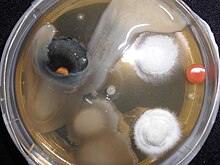
Back Ontsmetting Afrikaans تعقيم (أحياء دقيقة) Arabic Sterilizasiya Azerbaijani Стэрылізацыя Byelorussian Стерилизация (микробиология) Bulgarian জীবাণুমুক্তকরণ Bengali/Bangla Sterilizacija BS Esterilització (microbiologia) Catalan ئەستێورکردن CKB Sterilizace (mikrobiologie) Czech

Sterilization (British English: sterilisation) refers to any process that removes, kills, or deactivates all forms of life (particularly microorganisms such as fungi, bacteria, spores, and unicellular eukaryotic organisms) and other biological agents (such as prions or viruses) present in or on a specific surface, object, or fluid.[1] Sterilization can be achieved through various means, including heat, chemicals, irradiation, high pressure, and filtration. Sterilization is distinct from disinfection, sanitization, and pasteurization, in that those methods reduce rather than eliminate all forms of life and biological agents present. After sterilization, an object is referred to as being sterile or aseptic.
- ^ Frerichs RR. "Definitions". www.ph.ucla.edu.
© MMXXIII Rich X Search. We shall prevail. All rights reserved. Rich X Search